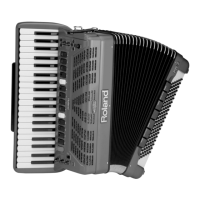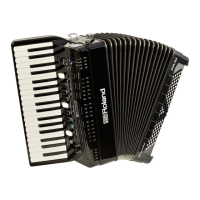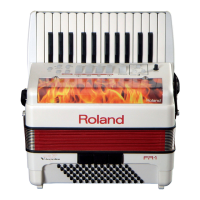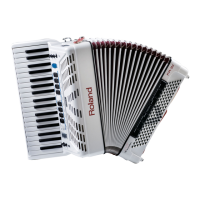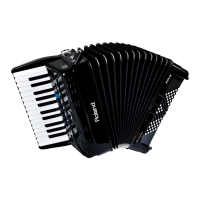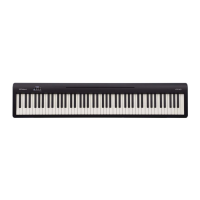Menu Options
80
N. Mfx Type N. Mfx Type N. Mfx Type
10 Compress 38
CHO Flgr
66 GT AmpSim
11 Limiter 39 CHO/DLY 67 Gate
12 Hexa-Cho 40 Flgr/DLY 68 Long Delay
13 Trem Cho 41 CHO/Flgr 69 Serial Delay
14 Space-D 42 Isolator 70 M. Tap DLY
15 St. Chorus 43 Low Boost 71 Reverse DLY
16. St. Flanger 44 Super Filter 72 Shue DLY
17 StepFlanger 45 Step Filter 73 3D Delay
18 St. Delay 46 Humanizer 74 Long Delay
19 Mod. Delay 47 Speaker Sim 75 Tape Echo
20 3 Tap Delay 48 Step Phaser 76 LoFi Noise
21 4 Tap Delay 49 MLT Phaser 77 LoFi Comp
22 Time Delay 50 INF Phaser 78 LoFi Radio
23 2 Pitch Shift 51 Ring Modul 79 Telephone
24 FBK Pitch 52 Step Ring 80 Phonograph
25 Reverb 53 Tremolo 81 Step Pitch
26 Gate Reverb 54 Auto Pan 82 Symp Reso
27
ODChorus
55 Step Pan 83 VIB-OD-Rot
28
ODFlanger
56 Slicer 84 Center Can
5.3 MFX Edit
The parameters in this page depend on the MFX
type that you selected.
Select and set the desiderate parameter.
For details regarding MFX edit parameters refer to
the“Tone & Drum Kit List “ supplementary manual.
Download it from the Web http:/ www.roland.com/manuals/.
5.4 MFX Control
Select this page to assign a control to the MFX.
Parameter Value Explanation
Control 1 Source O, EFX Pot, Aftert
Select “EFX Pot” to control
the MFX by “EFFECT”
potentiometer.
Select “After” to control the
MFX by aftertouch.
NOTE
The treble keyboard
of the piano-type
model also generates
aftertouch messages
(on the button- type
model, aftertouch can
be generated with the
Master bar). “Aftertouch”
refers to the fact that
you press a key even
further down after
playing a note.
Control 1 Sens -63~0~+63 Adjust the sensitivity.
Control 1 Assign
The eects to assign depend on the MFX type that
you selected. See “2.3 Eects Send” (p. 72).
Control 2 Source As “Control 1 Source”
Control 2 Sens As “Control 1 Sens”
Control 2 Assign As “Control 1 Assign”
Control 3 Source As “Control 1 Source”
Control 3 Sens As “Control 1 Sens”
Parameter Value Explanation
Control 3 Assign As “Control 1 Assign”
Control 4 Source As “Control 1 Source”
Control 4 Sens As “Control 1 Sens”
Control 4 Assign As “Control 1 Assign”
5.5 Sound Edit
The following parameters allow you to set the
sound’s “envelope” and lters.
The envelope parameters aect both the volume
(TVA) and the lter (TVF). The cuto frequency
will rise as the envelope rises and will fall as the
envelope falls.
Parameter Value Explanation
ATTACK -64~0~+63
This parameter adjusts the onset of the sound.
Negative values speed up the attack, so that
the sound becomes more aggressive.
DECAY -64~0~+63
This parameter adjusts the time over which
the sound’s volume and cuto frequency fall
from the highest point of the attack down to
the sustain level.
RELEASE -64~0~+63
This parameter adjusts the time over which
the sound will decay after the note is released
until it is no longer heard. The cuto frequency
will also fall according to this setting.
CUTOFF –64~0~+63
This lter parameter allows you to make the
selected sound darker or brighter.
Positive settings mean that more overtones
will be allowed to pass, so that the sound
becomes brighter. The further this value is set
in the negative direction, the fewer overtones
will be allowed to pass and the sound will
become softer (darker).
Characteristics of a low-pass lter
Characteristics of a low-pass lter
Setting
Frequency
Cuto frequency
NOTE
For some sounds, positive (+) Cuto
settings will cause no noticeable change
because the pre-programmed Cuto
parameter is already set to its maximum
value
DELAY –64~0~+63
This parameter adjusts the time required for
the vibrato eect to begin. Positive (+) settings
increase the time before vibrato will begin and
negative settings shorten the time
DEPTH –64~0~+63
This parameter adjusts the intensity of the
pitch modulation. Positive (+) settings mean
that the “wobble” becomes more prominent,
while negative (–) settings make it shallower.
RATE –64~0~+63
This parameter adjusts the speed of the pitch
modulation. Positive (+) settings make the
preset pitch modulation faster and negative
(–) settings make it slower.

